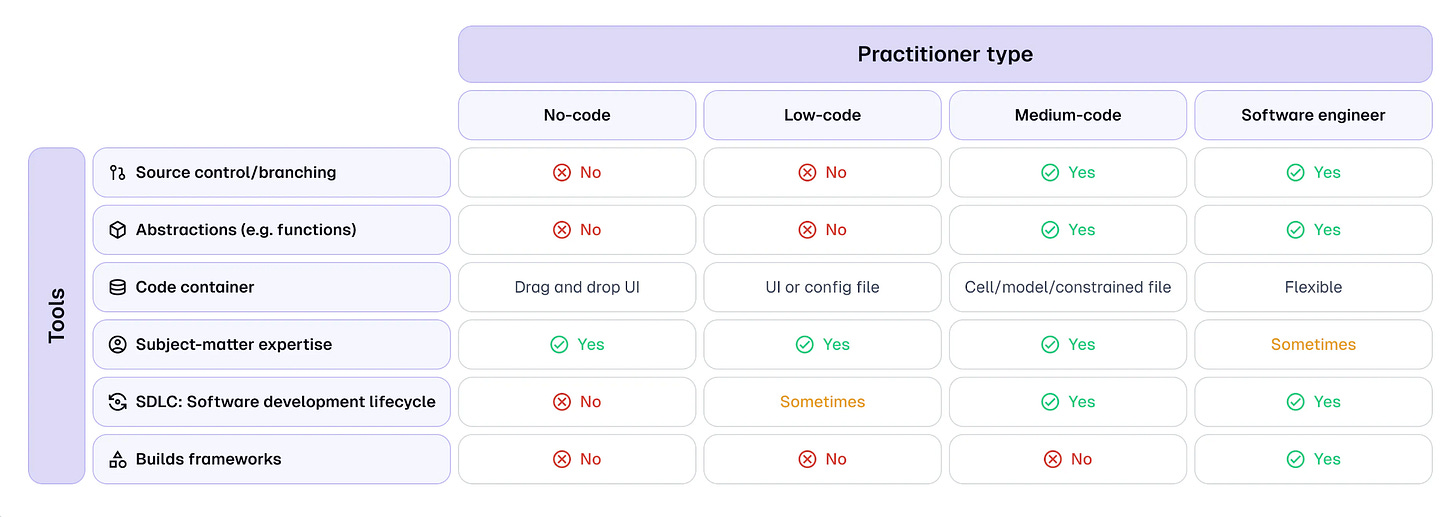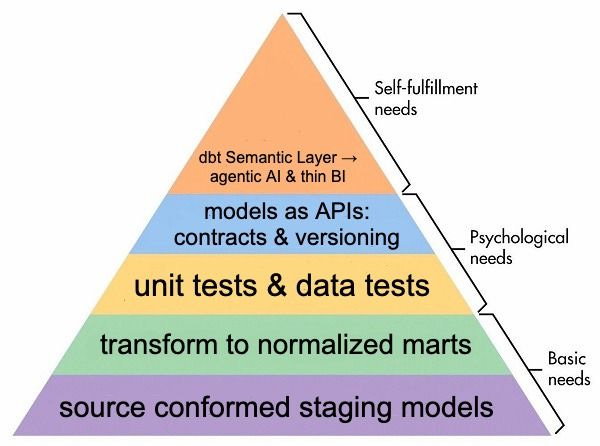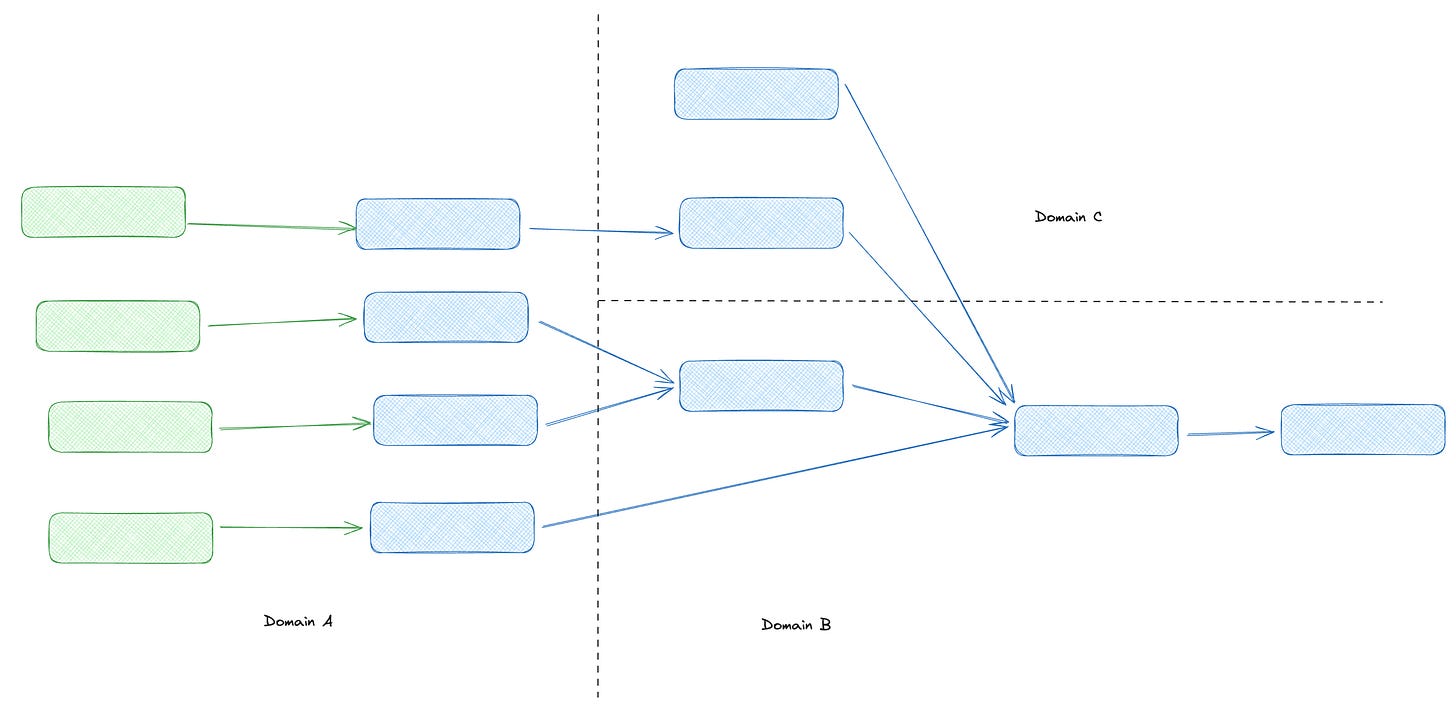Data work from the Goldilocks Zone and Medium Code
Not too hot, not too cold... just right
Hi folks! Back on the roundup here to talk through the goings on from across the data ecosystem.
Fresh dbt best practices:
We recently published major updates to our dbt Mesh and dbt Semantic Layer best practices guides. These guides are written in conversation with the dbt Community as a collaborative way of synthesizing what we’ve all learned about the craft of analytics engineering.
If one thing has been clear over the past few months it’s that the data space is evolving rapidly and will continue to do so - we’re committed to providing the tools and the resources that data practitioners need to keep up with the changing landscape.
dbt Mesh - We’re starting to see common patterns emerge in how organizations of different sizes adopt and structure their implementations of dbt Mesh. Of particular note is the enterprise data mesh, where truly global scale organizations manage dozens of dbt projects at scale, and the hub and spoke model, where central data teams serve several business aligned analytics teams.
Semantic Layer - we’ve updated the guide on Semantic Layer best practices to include recommendations on naming, structure, and development workflows based off insights from the Community as well as the dbt Labs data team. Expect to be hearing more from the dbt Labs data team soon - they’ve been hard at work implementing the Semantic Layer and have put together some great resources.
The Goldilocks Zone and the Rise of Medium Code
This past week I read two articles that are each fascinating independently, but taken together paint a compelling picture of the future of data work.
The Rise of Medium Code by Nick Schrock - this piece does such a great job packaging the ways in which the evolution of tooling and our understanding of technical work has allowed for the creation of a new type profession that exists at the intersection of software engineer best practices and domain expertise.
The Goldilocks Zone by Packy McCormick charts a midpoint between AI skeptics who think the current wave of AI hype and AI maximalists, who have us teetering over the precipice of an unknowable future. In the Goldilocks Zone, AI systems continue to evolve and in fact drive remarkable change in growth, but do so in a way that is fully comprehensible based on our existing models of technology and organizations.
Let’s start with Medium Code. Readers of this newsletter are likely intimately familiar with one category of profession that blends domain expertise and software engineering best practices - analytics engineering. Analytics engineering was based on the idea that data analysis and other data work, traditionally locked up either in spreadsheets or slow moving enterprise ETL workflows, could be accelerated by giving domain experts the tools to build their own code-based production systems.
The rise of cloud data warehouses made it much easier to run more analytics workloads, more frequently, with less technical overhead. Far from leading to the downfall of data as a profession, it enabled the creation of analytics engineering and allowed for data professionals to be able to provide more output than before.
Nick applies a level of abstraction to this with the generalizable concept of a “Medium Code” practitioner. Medium code practitioners can essentially be thought of as an emerging class of practitioners that blend traditional domain experts with code-based technical professions. Critically, they can provide much of the value of software engineering workflows, without having to be software engineers themself.
This point in particular is a huge unlock for the practitioner and for the business. Instead of the costly and exhausting process of convincing software engineers to do something and repeatedly providing them enough context and feedback to drive end-to-end change, a subject matter expert can just do it themselves.
So what exactly does a medium-code practitioner do / not do?

It’s very useful to have the abstraction of Medium Code, not only does it clarify the work of analytics engineering but it frames it as part of a broader pattern emerging. Nick brings up the fact in data we have analytics engineers (analysts x software engineer) and data scientist (statistician x software engineer), but that we can also consider users everything from Infrastructure as code tools like Terraform to next.js developers as medium code practitioners. You can imagine similar patterns taking place across the org chart.
Medium Code and LLMs
The blending of domain expertise and technical systems makes people that work in medium code a natural fit for owning and adopting LLM based workflows.
One funny thing about writing these days is you’re also implicitly making a bet on how AI will progress. Nick thinks we’re going to end up in the Goldilocks Zone where LLM systems will meaningfully increase the productivity and impact of knowledge workers, but will not be taking the driver’s seat for the most complex or important work we do.
Given the current state of LLMs, we do not believe in a future world state where unsupervised, multi-step agents produce meaningful software systems or autonomously drive systemic change in existing complex systems. Nor do we believe that AI is merely a parlor trick or fad. Instead, we see in a future that straddles these two extremes.
AIs need constraints and context to work effectively. They are wholly incapable of conceiving and designing coherent, novel, complex systems, and will not be for the foreseeable future, without massive changes in model architecture. There will always be context-specific terms, concepts, and logic that are unknowable to a generalized model. AIs operate within the context of such systems. As result the engineers that design and architect those systems will only become more valuable.
This suggests a world where all of the expertise we have been building not only stays relevant, but becomes even more relevant as AI tooling scales the impact of technical domain experts. We solve a hard problem once, encode it in a Medium Code system and then the LLMs are able to integrate that knowledge.
My first taste of working in the Goldilocks Zone
We can think of this as data work in the Goldilocks Zone1, where LLMs provide a powerful new toolset that removes a huge amount of toil and extends the benefit of the work that we do.
I felt this hands on last fall, when myself and the DX team were working to recreate a natural language → data benchmark in the dbt Semantic Layer. A paper had just come out showing that tools like knowledge graphs can make LLMs more reliable when working with data questions.
We had gotten the skeleton of the project working, with our metrics built, our connection to the LLM built out and our prompt down. But we were stubbornly not getting the right answers to a few of the questions.
The reason - this was a pretty thorny dataset. This bunch of questions all required you to filter on a specific column to determine whether a specific ID was referring to "policyholders" or "agents."
So I went in and I added a simple change to the project. I described my understanding of the data, in natural language, in the description of the fields and dimensions that were relevant to this query.
All of a sudden - every question that had been failing due to this confusing naming scheme went from returning the correct answer 0% of the time to returning the correct answer nearly 100% of the time.

I had this really visceral sense that I had, for the very first time, performed a workflow that moving forward would fundamentally change how I work. I’ve felt this way exactly once before in my career, when I first got introduced to dbt in 2017.
Much like cloud data warehouses extended the impact of data work and gave rise to the data flavored medium code workflows we know and love, in the Goldilocks Zone LLMs will extend this impact once further. You’ll still need to know understand your data, craft well architected data pipelines and understand the human and technical systems downstream from them. But the impact of your work will be magnified by a new set of tools that allows you to encode more of your baseline knowledge into these systems, letting you move up the stack and focus on higher order problems.
This newsletter is sponsored by dbt Labs. Discover why more than 30,000 companies use dbt to accelerate their data development.
Adding my normal caveat here that this is one view of the progress AI could take - maybe progress stalls tomorrow and these systems never prove more than toys or maybe 3 years from now we’re all embroiled in The Project - this is just one view of what the future might hold



